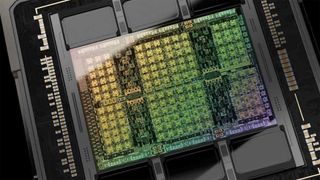Nvidia to ship a billion of RISC-V cores in 2024
Nvidia quietly adopts RISC-V and replaces proprietary microcontrollers.

Although Nvidia's GPUs rely on proprietary CUDA cores that feature their instruction set architecture and support for various data formats, these cores are controlled by custom cores that rely on the industry-standard RISC-V ISA, albeit with some extensions, the company revealed at the RISC-V Summit this month (via NickBrownHPC).
Modern GPUs are highly complex system-on-chips with a massive number of functions and resources — starting from compute resources and power management and all the way to display engines and security — that must be managed.
These things are now managed by 10 to 40 custom RISC-V cores developed by Nvidia, depending on chip complexity. Nvidia started to replace its proprietary microcontrollers with RISC-V-based microcontroller cores in 2015, and by now, virtually all of its MCU cores are RISC-V-based, according to an Nvidia slide demonstrated at the RISC-V Summit.
By now, Nvidia has developed at least three RISC-V microcontroller cores: NV-RISCV32 (RV32I-MU, in-order single-issue core), NV-RISCV64 (RV64I-MSU, out-of-order dual-issue core), and NV-RVV (RV32I-MU, NVRISCV32 + 1024-bit vector extension). These cores (and perhaps others) replaced the proprietary Falcon microcontroller unit based on a different instruction set architecture. In addition, Nvidia has developed 20+ custom RISC-V extensions for extra performance, functionality, and security.
Perhaps the most important RISC-V-based part of Nvidia GPUs is its embedded GPU System Processor (GSP). According to Nvidia's website, the first GPUs to use RISC-V-based GSP were based on the Turing architecture. This GSP offloads Kernel Driver functions, reduces GPU MIMO exposure to the CPU, and manages how the GPU is used.
Since MCU cores are universal, they can be used across Nvidia's products. As a result, in 2024, Nvidia is expected to ship around a billion RISC-V cores built into its GPUs, CPUs, SoCs, and other products, according to one of the demonstrated slights, which highlights the ubiquity of custom RISC-V cores in Nvidia's hardware.
Nvidia ships millions of GPUs every year. In 2023 alone, Nvidia shipped 31 million desktop discrete GPUs (according to Jon Peddie Research), around the same number of standalone GPUs for laptops, several millions of data center GPUs, and plenty of other types of hardware. That said, multiple RISC-V cores exist in all of Nvidia's chips.
Stay On the Cutting Edge: Get the Tom's Hardware Newsletter
Get Tom's Hardware's best news and in-depth reviews, straight to your inbox.

Anton Shilov is a contributing writer at Tom’s Hardware. Over the past couple of decades, he has covered everything from CPUs and GPUs to supercomputers and from modern process technologies and latest fab tools to high-tech industry trends.

Ayaneo's futuristic eGPU goes up for preorder at $599 — AG01 Starship Graphics Dock features RX 7600M XT GPU, OCuLink interface, Gigabit Ethernet, and M.2 2280 SSD support

Nvidia reports the latest GeForce drivers are causing issues in Corsair iCUE and Bluestacks — Users need to rollback drivers as a temporary fix
Most Popular






